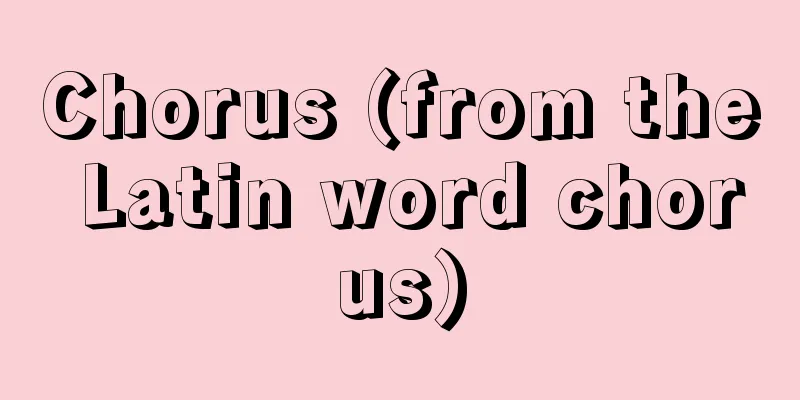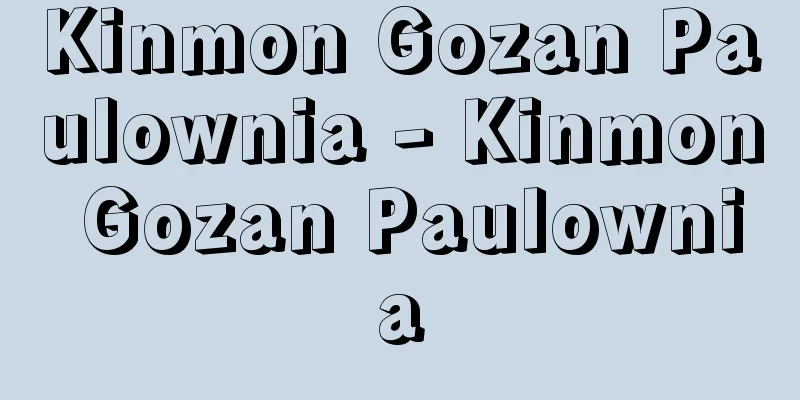Chorus (from the Latin word chorus)

|
Singing by a group. Chorus. The simplest form of chorus is when multiple people sing only one part, but this is usually distinguished as unison or unison. In the narrow sense, chorus refers to a form in which multiple people sing multiple parts. There are various possibilities depending on the combination of voice qualities and the number of voices. The types of combination of voice qualities are generally divided into children's choirs, male choirs, female choirs, and mixed choirs. In each case, the number of voices starts from two, but the standard form is four for male choirs, three for female choirs, and four for mixed choirs (soprano, alto, tenor, bass). Also often used are double choirs using two contrasting groups, or compound choirs using three or more groups. Choruses have ancient origins, and records show that high-level choral singing was already practiced in prehistoric times. Excellent choral music also existed in ancient Egypt, Judaism, and Greece. For example, Greek choruses were called choruses, and were sung in monophonic form in plays and other settings. From the early Christian era through the Middle Ages, monophonic hymns became popular in Europe, and a golden age of choral music in the form of unison singing emerged. From around the mid-Medieval period, polyphonic choruses in the narrow sense emerged as a form of church hymn, but until around the 13th century, polyphonic hymns were often in the form of duets, with each part sung by one person. It is said that full-scale polyphonic choral singing did not become common until the 14th century. From this time onwards, choral music began to be highly regarded as an important expression of church liturgical music. In the 15th century, Dufay's mass established the choral style as we know it today, but the sacred choral music written by Netherlandish composers active from the end of the 15th century to the 16th century, including Josquin des Prez, ushered in a golden age of choral music. The number of voices varied from four to three, six, eight or even ten, but religious choral music of this period often had overlapping voices with instruments, and the so-called a cappella style (in a chapel style) with only human voices was rare. The a cappella style became popular in Rome in the second half of the 16th century with Palestrina's mass and motets. In the 16th century, secular music in the form of duets such as chansons, madrigals and frottola were popular, but today these are often sung in choral form. In the Baroque period after the 17th century, choruses changed to large-scale forms with instrumental accompaniment. Not only were such large-scale choral pieces favored in Catholic liturgical music, such as masses, as had been the case up until that point, but church cantatas and other similar works were also actively created in the field of Lutheran Protestant church music. The choruses in Bach's church cantatas in particular can be said to be the highlights of choral music in the Baroque period. Choruses also played an important role in the operas and oratorios that first appeared in this period. The oratorio, established by Calissimi and reaching its peak with Handel, is a treasure trove of choral music. However, during the Classical period in the second half of the 18th century, choral music began to be composed less frequently as symphonies and chamber music began to take center stage as musical genres, but some excellent choral pieces were still produced, including works by Haydn, Mozart, and Beethoven. In the 19th century, choral music became popular again. Behind this was a social event, the rise of the middle class. This phenomenon started particularly early in England, where amateur enthusiasts were already singing secular choral music composed for them in the 18th century, preparing the way for the rise of choral music in the 19th century. In the 19th century, the amateur choral movement also became popular in France and Germany, and many composers wrote secular choral music for these choirs. Most of these were short pieces with no accompaniment or only piano accompaniment. On the other hand, many great composers wrote large-scale choral music with orchestral accompaniment. Another choral music of this era that cannot be overlooked is the choral music sung in opera. Verdi and Wagner in particular used choral music effectively in their operas. In the 20th century, choral music in various styles was produced in various countries. The forms were also diverse, ranging from unaccompanied to large-scale pieces with orchestral accompaniment, and it can be said that the various possibilities of choral music were pursued. Since the Second World War, creative activity has flourished in Japan, and excellent choral works have been produced one after another by modern Japanese composers. This is due to choral activities as part of school music education, and the active movement of amateur choirs that developed along with it. Furthermore, choral arrangements of folk songs and popular music from various countries are also popular, and it can be said that choral music is currently entering an era of prosperity again. [Imatani Kazunori] "The History of Choral Music by Tatsuo Minagawa (1965, Zen-On Music Publishers)" ▽ "Choral Music: Its History and Works" edited by A. Jacobs, translated by Masaru Hirata and Yoko Matsudaira (1980, Zen-On Music Publishers) Source: Shogakukan Encyclopedia Nipponica About Encyclopedia Nipponica Information | Legend |
|
集団による歌唱のこと。コーラス。一つの声部のみを複数の人々が歌う場合がもっとも単純な合唱の形態であるが、普通これは斉唱またはユニゾンとして区別することが多い。狭義の合唱は、複数の声部をそれぞれ複数の人々によって歌う形をいう。それには、声質の組合せ、声部の数によって、さまざまな可能性が考えられる。声質の組合せの種類は一般に、児童合唱、男声合唱、女声合唱、混声合唱に分けられる。いずれの場合も、声部の数は2声部からあるが、男声合唱は4声部、女声合唱は3声部、混声合唱は4声部(ソプラノ、アルト、テノール、バス)が標準的な形とされる。また2組の合唱を対比的に用いた二重合唱、あるいは3組以上の合唱による複合唱の形もしばしば用いられる。 合唱の起源は古く、有史以前に、すでに程度の高い合唱が行われていたことは、記録などから明らかである。古代のエジプト、ユダヤ、ギリシアなどでも優れた合唱音楽が存在していた。たとえば、ギリシアの合唱はコロスとよばれ、劇のなかなどで単旋律の形で歌われた。初期キリスト教時代から中世にかけて、ヨーロッパでは単旋律による聖歌が盛んとなり、斉唱の形態による合唱音楽の黄金時代が現出した。中世中期ごろからは、多声による狭義の合唱が教会聖歌の一形態として生まれてくるが、13世紀ごろまでの多声聖歌は、各声部を1人ずつで歌う重唱の形が多かった。多声による本格的な合唱の形が一般化してくるのは、14世紀になってからとされている。 このころから、合唱音楽は教会の典礼音楽の一つの重要な表現としてもてはやされるようになった。15世紀には、デュファイのミサ曲によって今日の概念による合唱様式が確立されるが、ジョスカン・デ・プレをはじめとする、15世紀末から16世紀にかけて活躍したフランドル楽派の作曲家たちが書いた宗教合唱曲によって、合唱音楽は黄金時代を迎えることになる。声部数は4声を中心として3声から6声、さらには8声、10声など多彩であったが、この時期の宗教合唱曲は、楽器で声部を重複させる場合が多く、人声のみによるいわゆるア・カペラ(a cappella=礼拝堂風に)の形はまれであった。ア・カペラの形は、16世紀の後半のローマで、パレストリーナのミサ曲やモテトゥスなどによって一般化した。16世紀には、シャンソン、マドリガーレ、フロットラなどの重唱の形による世俗曲が愛好されたが、今日ではこれらも合唱の形で歌うことがしばしばある。 17世紀以後のバロック時代になると、合唱は器楽伴奏付きの大規模な形に変化していった。それまでのように、ミサ曲をはじめとするカトリックの典礼音楽で、このような大規模な形態の合唱曲が好まれただけでなく、ルター派のプロテスタント教会音楽の分野でも、同様の形による教会カンタータなどが盛んにつくられた。なかでもバッハの教会カンタータにおける合唱は、バロック時代の合唱曲の白眉(はくび)といえよう。またこの時代に初めて登場したオペラやオラトリオでも、合唱は重要な役割を果たしていた。とくにカリッシミによって確立され、ヘンデルによって最高潮に達したオラトリオは、合唱曲の宝庫である。 しかし、18世紀後半の古典派の時代になると、音楽の中心ジャンルとして脚光を浴び始めた交響曲や室内楽曲などに押されて、合唱音楽の創作はあまり多く行われなくなる。それでも、ハイドン、モーツァルト、ベートーベンの作品をはじめ、いくつかの優れた合唱曲が生み出された。 19世紀に入ると、ふたたび合唱音楽がもてはやされるようになった。その背景には、中産市民階級の台頭という社会的なできごとがあったといえる。とくに、早くからこの現象がおこったイギリスでは、すでに18世紀ごろからアマチュア愛好家たちが彼らのためにつくられた世俗的合唱曲を歌っており、19世紀の合唱音楽の隆盛を準備していた。19世紀には、フランスやドイツでもアマチュア合唱運動が盛んとなり、そうした合唱団のために多くの作曲家が世俗合唱曲を書いた。それらのほとんどは無伴奏かピアノ伴奏のみによる小品であった。一方、管弦楽伴奏による大規模な合唱曲も、大作曲家たちによって多く書かれている。また、この時代の合唱曲として見逃せないのは、オペラのなかで歌われる合唱である。とくにベルディとワーグナーは、そのオペラで合唱を効果的に使用した。 20世紀も、各国でさまざまな様式による合唱曲が生み出されている。形態も無伴奏から管弦楽伴奏付きの大規模なものまで多種多様で、合唱の種々の可能性が追究されているといえる。第二次世界大戦以後は日本における創作活動も盛んで、現代日本の作曲家たちによる優れた合唱作品が次々と生み出されてきている。これには学校音楽教育の一環としての合唱活動、そしてそれに伴って発展したアマチュア合唱団の活発な運動が背景にある。さらに一方では、各国の民謡やポピュラー音楽の合唱用編曲も盛んで、合唱音楽は現在ふたたび隆盛の時代を迎えつつあるといえよう。 [今谷和徳] 『皆川達夫著『合唱音楽の歴史』(1965・全音楽譜出版社)』▽『A・ジェイコブス編、平田勝・松平陽子訳『合唱音楽――その歴史と作品』(1980・全音楽譜出版社)』 出典 小学館 日本大百科全書(ニッポニカ)日本大百科全書(ニッポニカ)について 情報 | 凡例 |
>>: Cession (English spelling)
Recommend
Ujikoju - Shrine parishioners
〘 noun 〙 People who worship the same tutelary deit...
Little Grebe (English spelling) grebe
A general term for birds in the Podicipedidae fami...
Buying Continuation - Kaitsunagi
…If the price rises during this time, the futures...
Angura hotpot - Agura hotpot
Kanagaki Robun's comic novels. Three volumes,...
Ball belt - Kyutai
The part of a sphere that is sandwiched between tw...
Sumida Manor - Sudanosho
This manor spread north and south on both sides o...
Fujiidera [city] - Fujiidera
A city located in central Osaka Prefecture, on the...
Abbottina rivularis (English name)
Also known as Doromoroko and Sunamoroko. A freshwa...
Cerargyrite
...There are approximately 60 known minerals that...
Paul Adrien Maurice Dirac
British theoretical physicist. Born in Bristol, h...
Malagasy mongoose (English spelling)
...general term for mammals of the subfamily Mong...
Knockdown move - Knockdown move
…(1) Suriage-waza: A technique in which you sweep...
Japanese newt
A typical newt of the Trituridae family (illustrat...
Pellaea rotundifolia (English spelling)
…[Shigeyuki Mitsuda]. … *Some of the terminology ...
Alonso, Alicia
Born: December 21, 1920, Havana [Died] October 17,...









